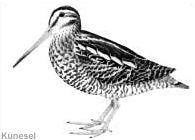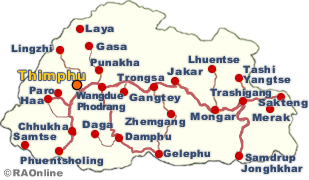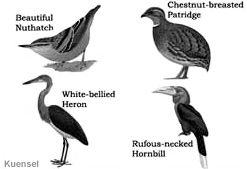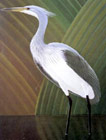|
Bhutan's
Nature - Animals
|
 |
Bhutan Nature Animals |
|
 |
Bhutan Information |
|
|
 |
| Thimphu valley loses Wood Snipe |
 |
 |
Wood Snipe
Even
as tourists visiting Bhutan are on the rise some rare and at one time,
regular visitors to Thimphu valley have stopped coming altogether.
The Wood
Snipe (Gallinago Nemoricola), an endangered species, which used to
be found in marshy areas around Thimphu are no more seen today according
to the Royal Society for the Protection of Nature. |
About
four Wood Snipes were last seen near the RICB colony in 1999 by the society's ornithologist Rebecca Pradhan. "Four is a good number
because they are hardly seen and since then we have not seen a single Wood
Snipe in the valley."
 |
Their
gradual disappearance is attributed to the destruction of their natural
habitat by increasing human activity in the city. The construction boom,
other developmental activities and indiscriminate disposal of waste in
the capital have destroyed most of the marshy areas forcing the Wood Snipes
to abandon their homes according to the society.
Though
the exact number of Wood Snipes in Bhutan is not yet determined, the worldwide
population of the bird is estimated to be around 2,500 to 10,000. |
Wood
Snipes breed in the Himalayas and the mountains of China wintering south-wards
to southern India, Myanmar, Bangladesh, Thailand and Bhutan.
top
|
620
recorded bird species in Butan
|

|
 |
With
the marshy areas around the town being encroached by human beings, the
population of winter migrant birds like the Wood Cock (Scolopax Rusticola), Jack
Snipe (Gallinago Gallinago), Button Quail (Cortunix Cortunix) and Crakes (Porzana Fusca) are also fast losing their homes.
"Birds
are an important link in the ecology and losing them would mean losing
an important link that would indirectly affect us," said Rebecca. |
|
Another
bird species that has drastically reduced is the Common Finch or Snow
Birds (Carpodacus Erythrinus).
"According
to the society, the finches were a very common sight during the winter
in the early seventies. A single flock of hundreds of finches would be
seen swooping and flying during winter when Thimphu was covered in heavy
snow.
The
number have now dwindled to about 20 to 30 birds with less snow fall in
the capital over the years, the society says. Thimphu with a small population
was a far colder place during those times hence getting far more snowfall
than today, according to the society.
The
society also points out that the on-going construction of the Thimphu-Babesa
Expressway has also destroyed a lot of bird habitats. The birds, because
of increased movement of traffic, frequent less the few marshy areas alongside
the expressway. Similarly, the on-going river diversion work of the Thimphu-chu has also resulted in further loss of bird habitats. According to the 'Birds
of Bhutan' compiled by Carol and Tim Inskkip, there were about 620
recorded bird species in the country.
Bird
habitats of Bhutan are roughly divided into forest, scrub, wetlands, and
alpine habitats, agricultural land and around human habitation
 |
| Forests
and bushes supported 84 percent of the country's breeding birds with 57
percent of the country's globally threatened birds and 90 percent of
the country's restricted-range birds dependent on forests.
Bhutan
is also home to other rare and globally endangered species like the Rufous-necked
Hornbill (Aceros Nipalensis), Beautiful Nuthatch (Sitta Formosa), Chestnut-breasted
Partridge (Aborophila Mandellii), White-bellied Heron (Ardea Insignis) and the well-known Black Necked Cranes (Grus Nigricollis). |
|
| Contributed
by Kuensel journalist Kinley Y Dorji |
 |
top
| Wildlife and People in Bhutan |
 |
| Information on Bhutan |
 |
| Links |
 |
|






